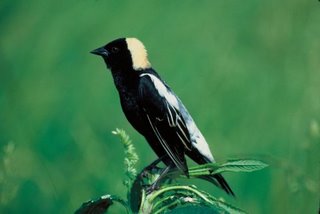Birds of the Mid-Atlantic #11: Bobolink
A flock of small dark birds suddenly rises out of a field with a chirping, bubbling call. Just as quickly, the flock settles back down in a different part of the field. What were they?
In my city of Washington, DC, a flock matching this description is most likely to be starlings, or perhaps one of the common species from the blackbird family. At this time of year, however, it is good to check such a flock for bobolinks. This species now occurs in DC only during migration. In the ridge and valley province of western Maryland and Virginia, bobolinks breed in hay fields.
Bobolinks are members of the icterids, the diverse family that includes blackbirds and grackles, meadowlarks, and orioles. A male bobolink is mostly black, but has a cream-colored patch on the back of its head, a large white rump, and broad white stripes where its wings meet its body (i.e., white scapulars). Females are sparrow-like in coloration, with dark brown wings, buffy bodies, and dark brown cap and eyestripe.
The distinctive appearance of this species has given rise to colorful nicknames. "Butter-bird" and "skunk blackbird" came about because of the white and cream-colored patches on its back and head. The appellation "ricebird" notes bobolinks' affection for grassy meadows and wild rice patches.
Since bobolinks spend much of their time foraging on the ground, one needs to be ready to spot them in flight. Luckily, several factors make this easier, if you know to look for them. Bobolinks are a highly social species, and travel in flocks, like cedar waxwings and some blackbirds. Such a flock is itself a clue that bobolinks may be present. In flight, the contrast in coloration between males and females is quite striking; look for flocks that include both black and light brown birds. The white patches on the otherwise black makes stand out quite readily if you see the birds from the side or rear. In addition, the song of the bobolink, frequently is helpful if you recognize it. Unfortunately I do not, but you can listen to samples here and here, as well as at the CLO site.
Like other grassland species, bobolinks have declined due to loss of habitat. This can be attributed to changes in agricultural practices, development of former farmland into suburban housing, and former fields being overtaken by woody vegetation. One solution that individual farmers can implement is to delay summer mowing from June until late July, after most nestlings have fledged. Such action would benefit not only bobolinks, but also other grassland species such as grasshopper sparrows and eastern meadowlarks. Grasslands managed for bobolinks should be mowed or burned at least every two years to reduce woody plants.
In my city of Washington, DC, a flock matching this description is most likely to be starlings, or perhaps one of the common species from the blackbird family. At this time of year, however, it is good to check such a flock for bobolinks. This species now occurs in DC only during migration. In the ridge and valley province of western Maryland and Virginia, bobolinks breed in hay fields.
Bobolinks are members of the icterids, the diverse family that includes blackbirds and grackles, meadowlarks, and orioles. A male bobolink is mostly black, but has a cream-colored patch on the back of its head, a large white rump, and broad white stripes where its wings meet its body (i.e., white scapulars). Females are sparrow-like in coloration, with dark brown wings, buffy bodies, and dark brown cap and eyestripe.
The distinctive appearance of this species has given rise to colorful nicknames. "Butter-bird" and "skunk blackbird" came about because of the white and cream-colored patches on its back and head. The appellation "ricebird" notes bobolinks' affection for grassy meadows and wild rice patches.
Since bobolinks spend much of their time foraging on the ground, one needs to be ready to spot them in flight. Luckily, several factors make this easier, if you know to look for them. Bobolinks are a highly social species, and travel in flocks, like cedar waxwings and some blackbirds. Such a flock is itself a clue that bobolinks may be present. In flight, the contrast in coloration between males and females is quite striking; look for flocks that include both black and light brown birds. The white patches on the otherwise black makes stand out quite readily if you see the birds from the side or rear. In addition, the song of the bobolink, frequently is helpful if you recognize it. Unfortunately I do not, but you can listen to samples here and here, as well as at the CLO site.
Like other grassland species, bobolinks have declined due to loss of habitat. This can be attributed to changes in agricultural practices, development of former farmland into suburban housing, and former fields being overtaken by woody vegetation. One solution that individual farmers can implement is to delay summer mowing from June until late July, after most nestlings have fledged. Such action would benefit not only bobolinks, but also other grassland species such as grasshopper sparrows and eastern meadowlarks. Grasslands managed for bobolinks should be mowed or burned at least every two years to reduce woody plants.
Labels: Birds of the Mid-Atlantic













1 Comments:
At Thursday, 25 May, 2006, D L Ennis said…
D L Ennis said…
Great post John and proper management of our grasslands is so crucial! One grassland bird I love is the bobwhite quail, and you sure don’t see them as often as you used too.
Post a Comment
<< Home